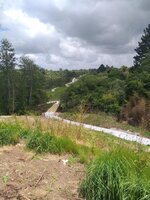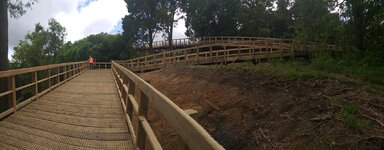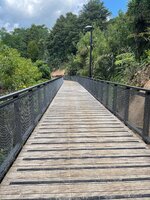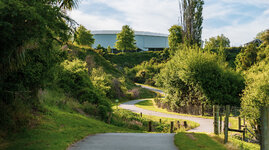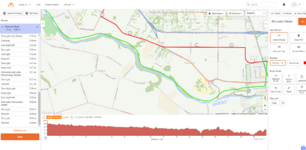powersquad
New Member
- Region
- New Zealand
Hello folks,
I am an unfit 36 year old weighing 200lbs looking at my first ebike for commuting to work primarily which is 25KM one way (16 miles) so 50KM return (32 miles). My office location has changed which was quite further out before where I had a free car park but at the new office location location that is 50KM return trip, I will have to find a paid car park and they are around NZD$1800. I figure, this commute is achievable via bicycle specially now that they have interconnected my small town with the major town where my job is via a dedicated cycleway that is mostly concrete path for 70% of the way and remaining is tar seal road.
At my new work building after few recent thefts in the car park where the bike stand is also, they have full fenced off the area with swipe card access apparently as I still have not been to the new office location yet. WFH is great but it will come to and end in a month's time so will have to commute to work atleast 3 days a week and 2 days WFH.
This will be my first ebike. I have been reading various threads here at EBR and watching videos on YouTube as well between different model bikes that has helped atleast narrow down I think between 2 brands Specialized and Trek.
The reason why I have picked these 2 brands is because there is local support for both these brands in my small town and also the major town where my work is. I ruled out Riese and Muller because the closest bike show that supports this brand is 1 hour and 30 mins away one way.
For the Trek, I picked the Allant+ 7S which is available in New Zealand at NZD$5999 incl tax (15%) (USD$4000 incl 15% tax). However my wife's workplace has a scheme with this specific chain of bike retailer that gives 12.5% discount and they happen to sell Trek so I can get the Allant +7S for NZD$5250 incl tax (USD$3500). There is barely any ebike stock available in the country due to big back orders. The retailer has 1 M and 1 L size left. I did a test ride on the M size today being 5'9 in height and the bike was a tight/perfect fit. The L size is brand new and they will have to build it which they can for a 10% deposit and will even return the deposit if I back out of both L or M size. I am thinking L size would fit me better. I am looking at the low step version so my wife who is 5'8 can also use it easily.
Being my first ever ebike ride, the Allant +7S was great experience. I climbed an steep incline which I would have huffed and puffed on a non e-bike but the Trek ploughed through it on low gear on turbo mode and I did not break a sweat. The motor was noticeably noisy.
I will contact the Specialized dealer tomorrow but I think due to being sold out everywhere that I can see online, I would be surprised if they would have any stock. I am interested in the 2022 Como 5.0 more and I like the connectivity and security lock options with motor being disabled. These likely will not be available until April 2022 including the 2022 Vado. These are NZD$8900 incl 15% tax (USD$6000).
1. Is the Specialized 2022 Como 5.0 worth it over Allant+ 7S with an extra price difference of NZD $3650 (USD$2500) for the chain version and $USD900 more on top for the IGH version?
2. Is one of these brands more reliable over the other specially with parts availability down the track as the battery would likely need to be replaced in 5 years time?
3. For commute mostly, if I did go down the path of Specialized, would Como suit better over Vado?
Edit - I just came back from the Specialized dealer and the allocation for 2022 bikes are extremely low. Like 1 unit low for 2022 Turbo Como 5.0 (non SL) which they reckon they will receive in January or Feb 2022 and they will not have anything after that until August 2022. I did a test ride on the 2021 Specialized Como they had on floor which was the M size and it's definitely the size I would want if go with Specialized. The bike rode well,. The motor also had noticeable noise but less than the Allant+ 7S. It did struggle on the hill I took it to even on low gear and I had to pedal hard but I suspected that from the SL being 35nm torque only and I am not fit (yet). The brakes were also not that strong or prompt to action unlike the Allant+ 7S. I suspect it might be 2 piston break unlike 4 piston on the Allant+ 7S.
I think it's between Turbo Como 5.0 vs Allant+ 7S for me. Both have good torque, build quality and 4 piston breaks. Specialized dealer has offered me $500 off which he said no other dealer will offer in the country in current climate and I believe him because I have not been able to find stock of ebikes in general anywhere in NZ. I can get the Specialized 2022 Turbo Como 5.0 for $8400 instead of $8900 incl tax so USD$5650 incl tax. USD$3500 for the Allant+ 7S. I did prefer the handles of Como SL over Allant+ 7S so I imagine the handles of 2022 Como will be similar as well.
Thanks.
I am an unfit 36 year old weighing 200lbs looking at my first ebike for commuting to work primarily which is 25KM one way (16 miles) so 50KM return (32 miles). My office location has changed which was quite further out before where I had a free car park but at the new office location location that is 50KM return trip, I will have to find a paid car park and they are around NZD$1800. I figure, this commute is achievable via bicycle specially now that they have interconnected my small town with the major town where my job is via a dedicated cycleway that is mostly concrete path for 70% of the way and remaining is tar seal road.
At my new work building after few recent thefts in the car park where the bike stand is also, they have full fenced off the area with swipe card access apparently as I still have not been to the new office location yet. WFH is great but it will come to and end in a month's time so will have to commute to work atleast 3 days a week and 2 days WFH.
This will be my first ebike. I have been reading various threads here at EBR and watching videos on YouTube as well between different model bikes that has helped atleast narrow down I think between 2 brands Specialized and Trek.
The reason why I have picked these 2 brands is because there is local support for both these brands in my small town and also the major town where my work is. I ruled out Riese and Muller because the closest bike show that supports this brand is 1 hour and 30 mins away one way.
For the Trek, I picked the Allant+ 7S which is available in New Zealand at NZD$5999 incl tax (15%) (USD$4000 incl 15% tax). However my wife's workplace has a scheme with this specific chain of bike retailer that gives 12.5% discount and they happen to sell Trek so I can get the Allant +7S for NZD$5250 incl tax (USD$3500). There is barely any ebike stock available in the country due to big back orders. The retailer has 1 M and 1 L size left. I did a test ride on the M size today being 5'9 in height and the bike was a tight/perfect fit. The L size is brand new and they will have to build it which they can for a 10% deposit and will even return the deposit if I back out of both L or M size. I am thinking L size would fit me better. I am looking at the low step version so my wife who is 5'8 can also use it easily.
Being my first ever ebike ride, the Allant +7S was great experience. I climbed an steep incline which I would have huffed and puffed on a non e-bike but the Trek ploughed through it on low gear on turbo mode and I did not break a sweat. The motor was noticeably noisy.
I will contact the Specialized dealer tomorrow but I think due to being sold out everywhere that I can see online, I would be surprised if they would have any stock. I am interested in the 2022 Como 5.0 more and I like the connectivity and security lock options with motor being disabled. These likely will not be available until April 2022 including the 2022 Vado. These are NZD$8900 incl 15% tax (USD$6000).
1. Is the Specialized 2022 Como 5.0 worth it over Allant+ 7S with an extra price difference of NZD $3650 (USD$2500) for the chain version and $USD900 more on top for the IGH version?
2. Is one of these brands more reliable over the other specially with parts availability down the track as the battery would likely need to be replaced in 5 years time?
3. For commute mostly, if I did go down the path of Specialized, would Como suit better over Vado?
Edit - I just came back from the Specialized dealer and the allocation for 2022 bikes are extremely low. Like 1 unit low for 2022 Turbo Como 5.0 (non SL) which they reckon they will receive in January or Feb 2022 and they will not have anything after that until August 2022. I did a test ride on the 2021 Specialized Como they had on floor which was the M size and it's definitely the size I would want if go with Specialized. The bike rode well,. The motor also had noticeable noise but less than the Allant+ 7S. It did struggle on the hill I took it to even on low gear and I had to pedal hard but I suspected that from the SL being 35nm torque only and I am not fit (yet). The brakes were also not that strong or prompt to action unlike the Allant+ 7S. I suspect it might be 2 piston break unlike 4 piston on the Allant+ 7S.
I think it's between Turbo Como 5.0 vs Allant+ 7S for me. Both have good torque, build quality and 4 piston breaks. Specialized dealer has offered me $500 off which he said no other dealer will offer in the country in current climate and I believe him because I have not been able to find stock of ebikes in general anywhere in NZ. I can get the Specialized 2022 Turbo Como 5.0 for $8400 instead of $8900 incl tax so USD$5650 incl tax. USD$3500 for the Allant+ 7S. I did prefer the handles of Como SL over Allant+ 7S so I imagine the handles of 2022 Como will be similar as well.
Thanks.
Last edited:


